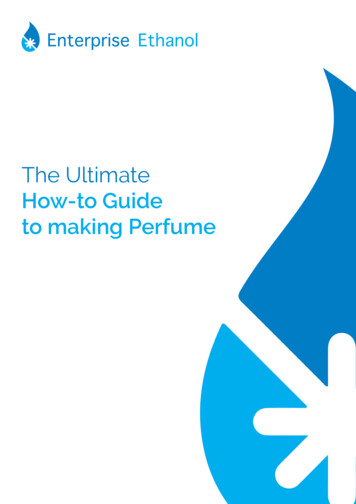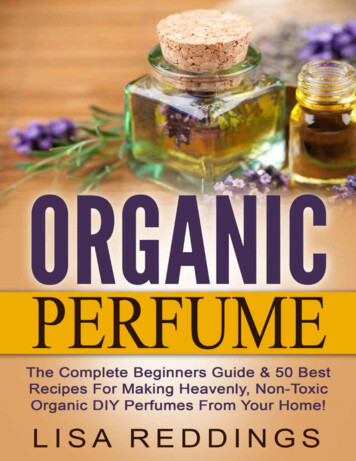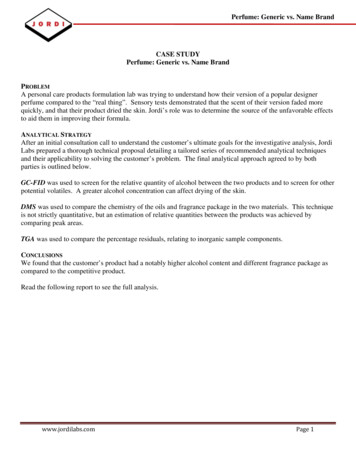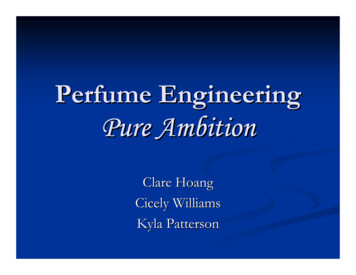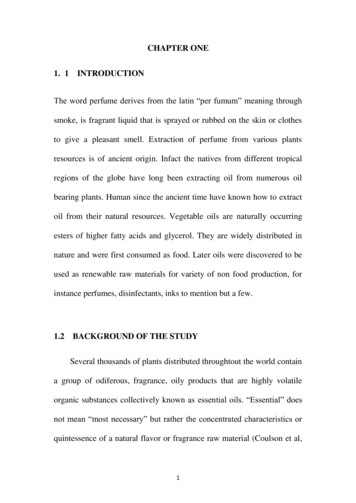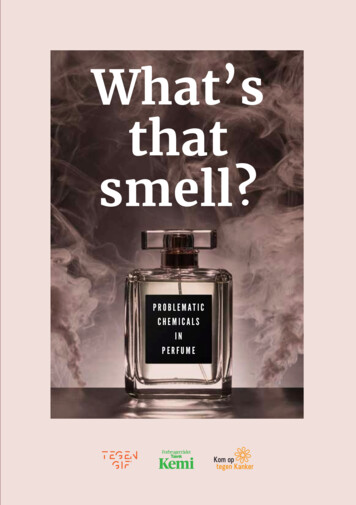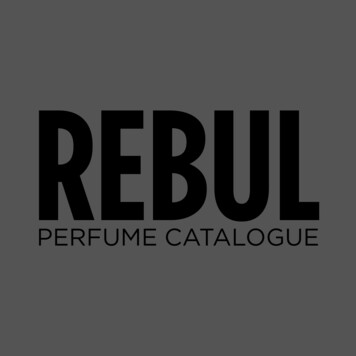
Transcription
International Journal of History and Cultural Studies (IJHCS)Volume 6, Issue 4, 2020, PP 26-45ISSN 2454-7646 (Print) & ISSN 2454-7654 (Online)DOI: ournals.orgHistory of the Perfume Industry in Greco-Roman EgyptDr. Doaa Ragab Fadel*Lecturer in Tourist Guidance department, High Institute of Tourism & Hotels, King Marriott – Alexandria*Corresponding Author: Dr. Doaa Ragab Fadel, Lecturer in Tourist Guidance department, High Instituteof Tourism & Hotels, King Marriott – AlexandriaAbstract: There's no doubt that in civilizations from Egypt to Greece, fragrance was spread as a vitalelement in life and death. Egypt was famous for its perfume throughout the ancient civilizations. In ancientEgypt, Alexandria was famous for the manufacture of perfumes and as the marketplace of several Egyptianproducts, such as myrrh. Mendes too was famous for its perfume.Indeed, perfumes were required for use in temples, rituals, ceremonies and festivals. There were variouswords in ancient Egypt used to refer to perfume, such as “ndm.st“(pleasant) and “rdw” (jar). In the temples,large quantities of incense, perfume and scented flowers were offered to the gods. Some gods were linked withspecific scents, such as Anubis god, who anointed the mummy with sacred oils to prevent the body fromdecaying.Besides, the ancient Egyptians used perfumes in many different forms to give an agreeable odor to the body.In particular, flowers and spices such as cinnamon and myrrh added fragrant scents to perfumes and oilsused in everyday life.In other words, recipes for and depictions of perfume preparation can be found in numerous ancient temples,while the recipes for perfumes were inscribed on the walls of the laboratories of the Ptolemaic temples.Theophrastus, the Greek philosopher, talked about the ways used to color perfumes and scents, such as thepigmentation used for red perfumes, which was alkanet from the plant Anchusa. Two Greek Kyphi “burntsubstance” recipes mentioned lists of ingredients for perfumes.Further, the perfumes were made from mixtures of several ingredients and three techniques seem to havebeen used; the substances were pounded, mixed together, and then put on the fire. Also the ancient Egyptiansused several kinds of herbs and plants to produce perfumes, such as iris. Iris root or balsam was used as abase for the ancient perfumes. While the most fragrant oils in ancient Egypt were myrrh, frankincense andlily, which were mixed with essences of flowers, fruits and herbs.Key words: Perfume, incense, cone, fragrance, recipes, scene, offering, container, Greek, Roman, oil,cosmetics, production, laboratoryResearch Methodology: Meanwhile this paper depended on the historical and artistic sides of perfumeindustry through Greco-Roman times as well as analyze and study the impact of perfume usage at recipes ofperfumes and perfumes' inscriptions at the temples and tombs, whether at daily life or religious ceremonies.Specifically, this research contained scenes of the ingredients of perfumes in the temples and tombs in GrecoRoman Egypt focus on the laboratory in the temples, where incense and perfumes were prepared and storedas well as offering scenes of the Ptolemaic and Roman. While it was hardly ever included perfumes workshopin the tombs because of the space to contain any laboratory of workshop inside the tombs.1. INTRODUCTIONFurther throughout the history of both Eastern and Western civilizations, perfume has marked societalcustoms related not only to everyday life but also rituals for the gods and for guiding the deceased tothe afterlife, such as the use of smoky odors to signify the divine or deified bodies (Tatomir, 2016).Thus, cosmetics' usage has been widespread as a part of daily life and religious rituals (Voudouri's &Tesseromatis, 2015). Also oils in Egypt were of vital importance against the drying heat of the sun,arid winds and hot air of the Nile Valley (Ruiz, 2001).Additionally, Perfumery is the art of collecting all the various fragrant essences (Heuze, 1862). Therewere several stages to producing perfumed substances, from cultivating the flowers, to storing oilsinto jars (EL-SHIMY, 2003). In the meantime, cosmetics and perfumes were an important part of lifeInternational Journal of History and Cultural Studies (IJHCS)Page 26
History of the Perfume Industry in Greco-Roman Egyptfor both sexes in ancient Egypt (Redford, 2001), making it an essential industry (Lesko, 1987).Besides the Egyptians made a great variety of ointments for the hair and body) (Heuze, 1862). As wellas, it was considered a suitable amusement for those attending feasts and, while eating, they wouldanoint themselves, or put on new necklets and exchange flowers (Erman, 1971).Currently, perfume was a major state industry, occupying a central role in Egypt's economy (Lesko,1987). Also they were discovered in Mesopotamia and Egypt, and constituted a significant part ofrituals, beauty and commerce (Voudouri & Tesseromatis, 2015). The use of perfume has beenidentified from as far back as the Predynastic period in Egypt, but most of the surviving recipes forperfume date from the Greco-Roman period (EL-SHIMY, 2003).In addition, in ancient Egyptian civilization, scent or perfume was used to epitomize authority anddivine sanction, acting as a powerful symbol. Therefore, aroma played a prominent and well-knownrole in their magic, religion and medicine (Tatomir, 2016). Due to the perfumes of ancient Egyptconsisted chiefly of fragrant oils and fats (ointments), the use of which is mentioned frequently inancient texts and by several Greek and Roman writers (Lucas & Harris, 2012;Toller, S., & Dodd,1993). Not only, had the ancient Egyptians specialized in perfume production in the Ptolemaic period,but also they exported perfumes all over the Mediterranean (Byl, 2012). Besides the Romans used dryperfumes to scent their clothes, a custom still prevalent among modern Greeks (Heuze, 1862).2. HISTORY OF USAGE OF PERFUMES IN ANCIENT EGYPTIn the past, Egyptian perfumery was famous across the Mediterranean (Voudouri & Tesseromatis,2015). As well as Pliny states that Egyptian perfumes were famous throughout the ancient world andthe classical authors knew and wrote about them (Byl, 2012). Also the art of perfume preparation issaid to have been born in ancient Mesopotamia and Egypt, and later refined by the Romans andPersians (Gadea, Vatca, & Vatca, 2017).Likewise, perfume was not only an expensive luxury, but a valuable export (Ruiz, 2001) and used bythe ancient Egyptians for three distinct purposes, offerings to the gods, embalming the dead, and usesin private life (Heuze, 1862), as follows: First, priests offered sweet scents to the gods three times aday (Northrup, Bentley, Jr, Manning, Pomeranz, & Topik, 2004). According to Homer, the Olympiangods taught people the secrets of perfume making and use, and it appeared in many scenes of Greekmythology (Gadea, Vatca, & Vatca, 2017). Second, perfume was essential to ensure the rebirth of thedeceased and a successful afterlife for him/her (Byl, 2012), therefore perfumes were used in themummification process as well, with sachets often placed around the neck of the deceased person(Northrup, Bentley, Jr, Manning, Pomeranz, & Topik, 2004). Third, in private life, the ancientEgyptians used perfumes on their hair and bodies (Butler, 2000), and in ritual and celebratorysituations, religious sacraments, marriage, funerary ceremonies and festive dinners. As well as beingused by athletes, aristocrats, politicians and royalty, they served as medicinal agents (Voudouri &Tesseromatis, 2015). In ancient Egypt, sacred writings were read to perfume holders as well as theEgyptian prescriptions were a mixture of perfumes were displayed in balls and burnt on hot coals torelease the perfume (Veiga, 2009; Lesko, 1987).In the times of Old Kingdom of ancient Egypt, specialists were in charge of the king's oils that wereprovided for use in the other world and kept in an ''unguent chamber'' (Manniche & Forman, 1999).Also, from the early New Kingdom to the Ptolemaic period, some representations of the ancientEgyptians show them wearing cones on their heads (Stevens, Rogge, Bos, & Dabbs, 2019). The coneswere symbolic representations of the invisible perfume worn by the banqueters (Price, 2018) andguests, both female and male, in banqueting scenes (Stevens, Rogge, Bos, & Dabbs, 2019) (Fig.1-2).For instance, there was a representation shows men and women with cones in their hair, which weremade of solid perfume in the form of scented wax (Lacovara, 2016). On special occasions, the ancientEgyptians were perfuming the body and garment with a sticky, sweet and aromatic fragrance (Ruiz,2001). For instance, wax cones have been discovered in Amarna that are thought to be symbols ofrebirth, fertility and the afterlife (Stevens, Rogge, Bos, & Dabbs, 2019) (Fig.3). Also, perfumedsubstances were used in the preparation of the head of the deceased (Strong, 2018).International Journal of History and Cultural Studies (IJHCS)Page 27
History of the Perfume Industry in Greco-Roman EgyptFig1. A lady with her cake of ointment (Voudouri & Tesseromatis, 2015).Fig2. Funerary Stelae from the south tomb cemetery from Amarna showing a seated man and woman wearinghead cones (Stevens, Rogge, Bos, & Dabbs, 2019; Erman, 1971).Fig3. Cone on the head of an individual of the Amarna (Stevens, Rogge, Bos, & Dabbs, 2019).In other word, the Greeks and Romans adopted the use of perfumes from the Egyptians (Northrup,Bentley, Jr, Manning, Pomeranz, & Topik, 2004) and Egyptian perfume was appreciated in classicalGreece, as indicated in Athenian texts (http://www.britishmuseum.org/Naukratis). For instance, TheGreeks in general did not enjoy perfume on a wide scale until the fourth century B.C., when thecivilization was at its height (Northrup, Bentley, Jr, Manning, Pomeranz, & Topik, 2004).Further Greece played a major role in the history of perfumes, not only through art, but also everydaylife (Gadea, Vatca, & Vatca, 2017). Also the Greeks used the perfumes at all their public festivals,where fragrant waters perfumed and refreshed the air (Heuze, 1862). While they loved the perfumes(Butler, 2000), not only offering them in their religious ceremonies as homage to their gods, but alsolooking upon them as a sign of their presence (Heuze, 1862). As well as the Greeks cremated theirdead, and the bones and ashes were afterwards washed in wine mixed with perfumed ointmentsInternational Journal of History and Cultural Studies (IJHCS)Page 28
History of the Perfume Industry in Greco-Roman Egypt(Butler, 2000). Following the Egyptian advancements, the ancient Greeks evolved the art of cosmeticsand perfume creation while developing and promoting their trade (Voudouri & Tesseromatis, 2015).Besides Alexander the Great favored the perfume trade of the East and made incense even morewidespread in Greece (Voudouri & Tesseromatis, 2015) such that the Egyptian influence becameprevalent during that time (Rhind, 2014). Therefore, the perfume industry reached its heyday inPtolemaic Egypt (Voudouri & Tesseromatis, 2015). For example, Queen Cleopatra greeted herRoman lover Antony in a ship with perfumed sails, her chambers strewn liberally with rose petals, sothat the Egyptian legacy of perfume reached Roman culture via the Greeks (Rhind, 2014).Clearly the traditional Roman use of perfumes remained limited up until the expansion of the empire,throughout which Rome then exported perfumes and oils (Northrup, Bentley, Jr, Manning, Pomeranz,& Topik, 2004). In the same way perfumes were used in daily personal rituals in Roman times, suchas in makeup, skin care and personal hygiene routines (Rhind, 2014). In the meantime, the Romansadopted the funeral rites practiced by the Greeks (Butler, 2000), and variations of the perfume conewere used by both ancient Greek and Roman ladies (Voudouri & Tesseromatis, 2015). Also Caligulaspent enormous sums on perfume and plunged into perfumed baths after his excessive orgies (Butler,2000) (Fig.4).Fig4. Toilet boxes for holding cosmetics, such as Kohl for the eyes, Henna for the fingers, and perfumed oils foranointing the body after a bath (Gosse, 2007).Thus, oils featured in rituals, served protective functions, and demonstrated family wealth,but also served cosmetic purposes (Wilfong, 2013; Brier, 2013; Strong, 2018).2.1. History of Perfume-Producing CitiesBesides the Egyptians produced perfume in Mendes and Alexandria during the Ptolemaic period,exporting to Rome and other cities on the Mediterranean Sea (Byl, 2012; David, 2007).2.1.1. MendesSpecifically, the 'Mendesian', named after the Egyptian Delta city of Mendes (Byl, 2012) located onthe Mendesian branch of the Nile (Bard, 2005) was considered the most excellent perfume in theancient classical world (Byl, 2012). Therefore, it's possible that the precious ancient ruins ofTimaiwas underneath the large city but inaccessible to archeologists (Zermani & Nawar, 2015)(Fig.5).Fig5. Map of Mendes and Timai (Zermani & Nawar, 2015).International Journal of History and Cultural Studies (IJHCS)Page 29
History of the Perfume Industry in Greco-Roman EgyptAs well as the type of pottery in Mendes that was used to make the large mixing vats were Hellenisticin style, thus dating from the 3rd or 4th century B.C, for example, Queen Cleopatra considered Timai'sperfume her special perfume. Additionally, there were shards of ceramic perfume bottles and amphorawere found in Mendes. Queen Cleopatra considered Timai's perfume her special perfume (Zermani &Nawar, 2015; David, 2007).2.1.2. AlexandriaIn addition, Alexandria's location made it the most important trade center of the Mediterranean region,a place where luxury goods such as perfumes were imported from the East, either stopping inAlexandria or passing through the city on their way to somewhere else (Escoffey, 2012). In themeantime, Alexandria was famous for the manufacture and perfection of perfume, and various typeswere widely used in the Pharaonic period (Green, 1996).2.2. Names of Perfumes in Ancient EgyptIndeed, the term "perfume” can be used to describe the oily extract of a plant, and derives from theLatin word "perfumum" which was used to describe scent mixtures conveyed by smoke (Voudouri &Tesseromatis, 2015; Gadea, Vatca, & Vatca, 2017). Also the Egyptians used words for the act ofsmelling such as tpj “sniff”, xnm “to smell or breath”, and stj “odor, smell or perfume” (Price, 2018).Meanwhile, the Egyptians used two general words for perfume: the first was ndm.st, derived from"ndm", meaning "pleasant", while the second was rdw, derived from “dw”, meaning “liquid”, as wellas two terms for different kinds of perfumes: "the Egyptian” and “eye of Horus” (Byl, 2012).While there was connection with the words of stAt ''lotus'' and xAw ''flower''. In other word,xAwwas first attested in the 18th Dynasty and translated as "plant" or "flowers". For instance,some scenes of the word xAw ''flower'' in the tomb of Petosiris as well as appear in Greco-Roman textsfound at the Dendera and Philae temples (Strong, 2018).2.3. Relationship Between Perfumes and Gods in Ancient EgyptFurther the gods had favored Egypt with the production of floral fragrances (Manniche & Forman,1999). Additionally, the deities of ancient Egypt were all fragrant beings, so cult statues wereanointed with perfumed oil in the daily temple ritual (Byl, 2012). Therefore, the daily worship wasperformed by the priest and the sacred chapel was cleaned and filled with perfume (Erman, 1971) toanoint the sacred images (Lacovara, 2016). In addition, with some figurines or statuettes, perfumeswere used to induce a deity to manifest itself in the temple (Pinch, 1994).In the meantime, in Greece, according to the Homeric tradition, Olympian gods taught people aboutthe use of perfumes (Voudouri & Tesseromatis, 2015). During the Ptolemaic period, cloth, which waspart of the divine essence, was offered along with perfume to the deities (Byl, 2012). While, floralwreaths were worn as crowns for religious festivities, in both the Egyptian and the Greek and Romanworlds (Riggs, 2006). Thus, perfume use was a part of Greek hospitality and social and culturalpractices (Voudouri & Tesseromatis, 2015).Besides Shesmu god was lord of the perfume and Hathor goddess was connected with perfume in itsvarious forms. Also, Nefertum god was considered lord of perfume (Byl, 2012) and oil makersbecause he was born of the fragrant blue lotus (Lacovara, 2016). While, during Apis god's lifetime, itwas perfumed each day. Further, Bastet goddess's name is written with the bas jar(bs) and a loaf(t), that is a vessel and holds perfume associated with her festivals (Remler, 2006). In addition,Hathor goddess was the mistress of myrrh, which links her to banquets, where perfume, in the form ofunguents containing myrrh and liquid perfume, was used (Byl, 2012). In other word, the Greeksconsidered the goddess Aphrodite hid and bushed of myrtle tree flowers, while the Romansconsidered the myrtle became a symbol of Venus goddess and marriage as well (Voudouri &Tesseromatis, 2015). Illustrated by, a scene in the Louvre museum, the god Osiris is depicted asAnubis god, with outstretched arms, behind a mummiform figure with a perfume cone and lotusblossom upon his head (Scalf, 2014) (Fig.6).International Journal of History and Cultural Studies (IJHCS)Page 30
History of the Perfume Industry in Greco-Roman EgyptFig6. Scene of presentation of mummy, Louvre Museum (Scalf, 2014).2.4. Ingredients of Perfume Production in Ancient EgyptCurrently ancient Egypt was the center of production for many exotic and luxury perfumes (Byl,2012), but the lack of variety of flowers in Greece meant that, like the Egyptians, they had to importingredients and then manufacture the perfume in their country (Northrup, Bentley, Jr, Manning,Pomeranz, & Topik, 2004). While from the 6th century onwards, the ancient Greeks imported palmoil, lily, lotus and dill from Egypt (Voudouri & Tesseromatis, 2015).Also perfumes are named in the earliest offering lists in the pyramid texts, as well as in tomb andcoffin inscriptions and funeral papyri (Butler, 2000). Further the Egyptians used many kinds ofperfumes (Erman, 1971), which were concocted from oils derived from plants, animal organs and thefat of such animals as the ox, goose, cat, hippopotamus and crocodile (Ruiz, 2001). While sometimescinnamon, cardamom, myrrh, honey, wine, or flowers were used to create fragrances (Remler, 2006;Watts, 1998).Besides plant dyes were an important part of the aromatic ingredients from flowers that wereincorporated into oils and fats for use in perfumes (Janick, 2002). Indeed, perfumes were divided intooils and solid perfumes, incense, perfumes in the form of unguent cones, and sacred unguent oils (Byl,2012). In the meantime, scholars can reconstruct the ingredients and raw materials of the Pharaonic,Greco-Roman perfumes from images found in tombs and from recipes (Redford, 2001) (Fig.7).Fig7. Scene depicting the gathering of lilies and expressing of oil of lily for perfumes (Janick, 2002).In other word, perfumes were created from various parts of plants: flowers, leaves, twigs, roots, wood,fruits, and gum (Butler, 2000), which could be mixed together using three different methods: the firstwas to immerse the flowers, the second to soak the flowers, fruits, and herbs in boiling oil, and thethird resembled the method used for manufacturing wine or oil (Fayed, 1998), examples includingSusinon which was made from lilies and Kypros, made from bergamot, mint, and thyme (Butler,2000).In particular, the word “seshen”, meaning lotus, occurs in a recipe found in the Edfu temple for useduring ceremonies for the opening of the mouth (Manniche & Forman, 1999), while the EgyptiansInternational Journal of History and Cultural Studies (IJHCS)Page 31
History of the Perfume Industry in Greco-Roman Egyptattributed specific symbolisms to the iris plant, such as power. Thus, it was used by their kings, whileiris parts were placed on the face of the sphinx. While one of the perfumes that was most well-knownto the Greeks was Kyphi (Erman, 1971), believed to be a mixture of 16 aromatic resins (Butler, 2000).As well as the name Kyphi is the Latin version of the Greek transcription of the Egyptian word Kapet,originally meaning any substance to be burnt (Byl, 2012). Meanwhile, Kyphi was used in greatquantities in the temples, and the recipes were recorded in stone on the walls of the buildings(Manniche & Forman, 1999), showing that myrrh, broom, frankincense, and several other ingredientswere used to make it (Erman, 1971).In general, recipes were written not only in Greek, but also in Egyptian hieroglyphs (Manniche &Forman, 1999). Indeed, relief paintings in ancient Egyptian art throughout the Ptolemaic period showthat specific recipes were inscribed in hieroglyphs on the walls of perfume “laboratories” located intemples (Byl, 2012). At that point, Theophrastus, Pliny, and Dioscorides relate various recipes forperfumes, such as the sweet perfume of marjoram that was painted with a dye, a root imported fromSyria (Voudouri & Tesseromatis, 2015). In the past, the Romans devised containers for theirperfumes, which could be in solid, liquid, or powder form (Butler, 2000).2.5. Scenes Showing Perfume in Ancient Egypt in Temples and Tombs2.5.1. TemplesCurrently in the early Ptolemaic period, temples were allowed to produce oil for their own use, but notto sell (Willy, 2010). While Greco-Roman temples had smaller rooms used as storerooms for culticequipment (Shafer, Arnold, Bell, Finnestad, & Haeny, 2005), and for the preparation of incense andperfumed oils (Byl, 2012), which were used for the morning rituals of the temple, such as to anointthe god with oils (Shafer, Arnold, Bell, Finnestad, & Haeny, 2005) and for the ritual of opening themouth, which was mainly a ritual for the consecration of divine statues (Quack, 2013). Also thestatues of the god were purified by libation and censing and by the presentation of pellets of Natronand incense for purifying their mouths (Fairman, 1954). As well as, in the Ptolemaic period,perfumers' workshops were linked to larger production centers containing grain mills, breweries,bakeries, and weaving shops (Byl, 2012).Specifically, there are two chambers at the Edfu and Dendera temples, called the treasuries of thetemples, one of which was the laboratory used to prepare the perfume or anoint the statues of the gods(Mariette, 1890). In the meantime, Instructions for the preparation of Kyphi and lists of ingredientswere found in inscriptions on the walls at the temples of Edfu and Dendera (Veiga, 2009). Aspalathosis an ingredient in the three Kyphi recipes written in Greek and in the recipes carved on the walls ofthe temples of Edfu and Philae (Manniche & Forman, 1999). For example, in many reliefs, womenare represented with their husbands; the women are holding lotus flowers (a symbol of love) and areshown as perfumed (Carolyn, 2010).2.5.2. Edfu TempleBeyond the hypostyle hall (Fairman, 1954), there are two chambers on the eastern and western sidesfor storing liquid and solid offerings (Wilkinson, 2000), the walls of which are inscribed with lengthyrecipes for the preparation of perfumes (Fletcher, 2010). Additionally, at the northwest corner ofhypostyle hall was the Laboratory, where incense was prepared and stored (Fairman, 1954) (Fig.8).For instance, the perfume laboratory in Edfu temple has a recipe carved in hieroglyphics on its walls(Byl, 2012), describing how incense was to be made (Weeks, 2005) for the preparation of perfume foranointing the goddess Hathor (Byl, 2012). Also another such recipe can be seen at the top left of therear wall (Weeks, 2005).Fig8. Plan of Edfu temple, showing the laboratory (Shafer, Arnold, Bell, Finnestad, & Haeny, 2005).International Journal of History and Cultural Studies (IJHCS)Page 32
History of the Perfume Industry in Greco-Roman EgyptSome of the scenes found in the laboratory of Edfu temple include the following:Clearly details of perfume preparation are inscribed on the walls of the laboratory of Edfu temple(Manniche, Perfume, 2009) (Fig.9).Fig9. Recipes for scents as recorded in the laboratory of the temple of Edfu (Manniche, Perfume, 2009).(1) On the exterior lintelAs with Ptolemy VI Philometor, with Cleopatra II standing behind him, is making offerings to theseated Edfu triad of deities, Horus, Hathor, and Harsomptus (Byl, 2012) (Fig.10).Fig10. An offering scene on the exterior lintel of the laboratory (Byl, 2012).(2) On the north wallLikewise, on the left side, Ptolemy VI is offering a statuette of a sphinx with a jar of perfume to Horusand Hathor while, on the right side, he is offering a jar of perfume to Horus and Hathor (Byl, 2012;Quack, 2013) (Fig.11).Fig11. Drawing of the frieze at the bottom of the north wall (Byl, 2012)International Journal of History and Cultural Studies (IJHCS)Page 33
History of the Perfume Industry in Greco-Roman Egypt(3) There is a formula on the lintel on the eastern part of the central hall of Edfu temple that is asfollows:Title and Formula:Hnk irpDd mdw mn n.k SAw srd n.k m tA Sspw ( ) bs n.k m Axt.k r sHaa ib.k ( .) wdn r nb pr.k msnty.fWords spoken, “take to yourself vines growing for you in the land, Shepsu plants ( .). Pouringout for you from your eye to make your heart glad ( .) offered to the lord of your house with itsperfume” (Metwally, 2009).2.5.3. Philae TempleBesides, the Ptolemaic rulers provided Philae with its presumed laboratory (Fletcher, 2010) (Fig.12).For instance, the temple of Isis has a perfume and incense laboratory at the south end of the eastcolonnade but the walls have no texts or reliefs inscribed on them. As well as there is a reliefdepicting King Ptolemy XII offerings jars of perfumed oils to the goddess Ma'at (Byl, 2012) (Fig.13).Fig12. Part of a Kyphi recipe. Inscription on a door jamb at Philae, 2 nd – 1st century BC (Manniche & Forman,Egyptian Luxuries: Fragrance, Aromatherapy, and Cosmetics in Pharaonic Times, 1999)Fig13. Offering scene on a column outside entrance to laboratory (Byl, 2012).Specifically, a visual representation of the fragrance from essential oils being extracted from an herbcan be seen in the Philae temple (Janick, 2002) (Fig.14).International Journal of History and Cultural Studies (IJHCS)Page 34
History of the Perfume Industry in Greco-Roman EgyptFig14. Scene showing the extraction of oils from a herb (Janick, 2002).2.5.4. Dendera TempleAt that point, around the hypostyle hall, there is a small chamber for the king to offer incense to thegoddess Hathor (Weeks, 2005) (Fig.15). While, in the east wall, Pepi I offers pD (incense) and sty(perfume) to several gods, such as Nekhbet and Hathor (Richte, 2012) (Fig.16).Fig15. Plan of Dendera Temple, showing the laboratory (Weeks, 2005).Fig16. 3rdregister, east wall of laboratory (Richte, 2012).International Journal of History and Cultural Studies (IJHCS)Page 35
History of the Perfume Industry in Greco-Roman EgyptAt that point, in the upper register of the north wall of the laboratory, the king, Caesar Augustus, isoffering perfume in a sphinx-shaped vessel to Hathor and Horus, after which the god Shesmu with thelion head is offering two jars of perfume (Fig.17). Also, in the lower register, Caesar Augustus iscensing before Hathor and he is followed by Nebtneteru offering vessels of perfume (Byl, 2012;Metwally, 2009; Murray, 2002; Hawass, 2000) (Fig.18).Fig17. Offering scene of Caesar Augustus on upper register on north wall of laboratory (Byl, 2012).Fig18. Offering scene of Caesar Augustus on lower register on north wall of laboratory (Byl, 2012).The following formula can be seen on the 2nd register of the south wall:Hr smar id.t Hr rdi.t id.t-nTr n Hr.t-tp“Clothing with perfume giving the divine perfume to the uraeus “.Another formula can be seen on the 3rd register of the east wall:nSp fnD tn m sty f m-n tn ir.t Hr ii sty s r tn"Your (pl.) nose breaths its (9m.s.) perfume. Take to yourselves the Eye of Horus, its perfume comesto you “(Richter, 2012).2.5.5. Kom Ombo TempleCurrently, the laboratory of Kom Ombo temple is badly damaged (Fig.19), but there is a relief on thelintel of two sphinxes holding perfume jars (Byl, 2012) (Fig.20).International Journal of History and Cultural Studies (IJHCS)Page 36
History of the Perfume Industry in Greco-Roman EgyptFig19. Plan of Kom Ombo temple, showing the laboratory (Weeks, 2005).Fig20. Relief of sphinx on lintel of laboratory (Byl, 2012).The following formula can be seen on a column in the central hall of the temple:Mn n.k xnmty m Hnq m Hknw Hr aawy.f snw Sps n Dt sk.n.f n.i tp.k m anTw in.n.i wrH.n.i Haw.k ibr mAaxrw.k iw.k iry.f m mAa xrw"Take to yourself the scent offered with oil upon my hands. August image of Djet. I anoint your headwith myrrh; I bring unguent for your body and perfume. May you be justified, you belong to him asone justified"(Metwally, 2009).2.6. TombsAlthough the manufacture of scent was a major industry in Egypt but no production centers have beenunearthed in the tombs as well as it was hardly ever included in the tomb decorations (Manniche,Perfume, 2009) (Fig.21). In the meantime, a perfumers’ workshop is depicted on a wall in the Thebantomb TT 175 in El-Khokha Necropolis, showing workers crush herbs, add them to a melting bowl,then shape them into balls (Janick, 2002; Byl, 2012) (Fig.22).International Journal of History and Cultural Studies (IJHCS)Page 37
History of the Perfume Industry in Greco-Roman EgyptFig21. Scene in the Amarna Royal tomb, showing princess Meketaten, who is wearing a head cone (Stevens,Rogge, Bos, & Dabbs, 2019).Fig22. Scene of perfume workshop, Theban tomb TT 175, El-Khokha (Janick, 2002; Byl, 2012)2.6.1. Tombs of Petosiris at Tuna El-Gebel NecropolisMean
perfume date from the Greco-Roman period (EL-SHIMY, 2003). In addition, in ancient Egyptian civilization, scent or perfume was used to epitomize authority and divine sanction, acting as a powerful symbol. Therefore, aroma played a prominent and well-known role in their magic, religion and med
